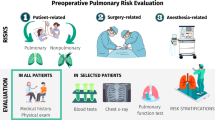Abstract
Purpose
Postoperative pulmonary complications (PPCs) occur in up to 30% of patients undergoing surgery and are a significant contributor to the overall risk of surgery. A preoperative risk prediction tool for postoperative pulmonary complications could succour clinical identification of patients at increased risk and support clinical decision making. This original study aimed to externally validate a risk model for predicting postoperative pulmonary complications (ARISCAT) in a cohort of patients undergoing major emergency abdominal surgery at a Danish University Hospital.
Methods
ARISCAT was validated prospectively in a cohort of patients undergoing major emergency abdominal surgery between March 2017 and January 2019. Predicted PPCs by ARISCAT were compared with observed PPCs. ARISCAT was validated with calibration, discrimination and accuracy and in adherence to the TRIPOD statement.
Results
The study included a total of 585 patients with a median age of 70 years. The majority of patients underwent emergency laparotomy without bowel resection. The predicted PPC frequency by ARISCAT was 24.9%, while the observed frequency of PPCs in the cohort was 36.1%. The slope of the calibration plot was 0.9546, the y axis interception was 0.1269 and the plot was well fitted to a linear slope. The Hosmer Lemeshow goodness-of-fit analysis showed good calibration (p > 0.25). ARISCAT showed good discrimination with AUC 0.83 (95% CI 0.79–0.86) on a receiver-operating characteristics curve and the accuracy was also good with a Brier score of 0.19.
Conclusions
ARISCAT was a promising tool to predict PPCs in a high-risk surgical population undergoing major emergency abdominal surgery.


Similar content being viewed by others
Availability of data and material
According to Danish law about data protection entire data material cannot be shared. However, if there are individual data material in relation to specific calculations the editors or reviewers request we will try our best to share that in a responsible and safe data protection manner.
Code availability
Not applicable.
References
Brooks-Brunn JA. Postoperative atelectasis and pneumonia. Heart Lung. 1995;24:94–115.
Epidemiology, practice of ventilation and outcome for patients at increased risk of postoperative pulmonary complications: LAS VEGAS—an observational study in 29 countries. Eur J Anaesthesiol. 2017;34:492–507. https://doi.org/10.1097/EJA.0000000000000646.
McCoy CC, Englum BR, Keenan JE, Vaslef SN, Shapiro ML, Scarborough JE. Impact of specific postoperative complications on the outcomes of emergency general surgery patients. J Trauma Acute Care Surg. 2015;78:912–8. https://doi.org/10.1097/TA.0000000000000611.
Khuri SF, Henderson WG, DePalma RG, Mosca C, Healey NA, Kumbhani DJ. Determinants of long-term survival after major surgery and the adverse effect of postoperative complications. Ann Surg. 2005;242:326–41. https://doi.org/10.1097/01.sla.0000179621.33268.83.
Linde-Zwirble WL, Bloom JD, Mecca RS, Hansell DM. Postoperative pulmonary complications in adult elective surgery patients in the US: severity, outcomes and resources use. Crit Care. 2010;14:P210.
Tengberg LT, Cihoric M, Foss NB, Bay-Nielsen M, Gögenur I, Henriksen R, et al. Complications after emergency laparotomy beyond the immediate postoperative period—a retrospective, observational cohort study of 1139 patients. Anaesthesia. 2017;72:309–16. https://doi.org/10.1111/anae.13721.
Vester-Andersen M, Lundstrøm LH, Møller MH, Waldau T, Rosenberg J, Møller AM. Mortality and postoperative care pathways after emergency gastrointestinal surgery in 2904 patients: a population-based cohort study. Br J Anaesth. 2014;112:860–70. https://doi.org/10.1093/bja/aet487.
Canet J, Gallart L, Gomar C, Paluzie G, Vallès J, Castillo J, et al. Prediction of postoperative pulmonary complications in a population-based surgical cohort. Anesthesiology. 2010;113:1338–50. https://doi.org/10.1097/ALN.0b013e3181fc6e0a.
Collins GS, Reitsma JB, Altman DG, Moons KG. Transparent reporting of a multivariable prediction model for individual prognosis or diagnosis (TRIPOD): the TRIPOD statement. BMJ. 2015;350: g7594. https://doi.org/10.1136/bmj.g7594.
Burcharth J, Abdulhady L, Danker J, Ekeloef S, Jørgensen T, Lauridsen H, et al. Implementation of a multidisciplinary perioperative protocol in major emergency abdominal surgery. Eur J Trauma Emerg Surgery. 2021;47:467–77. https://doi.org/10.1007/s00068-019-01238-7.
Mazo V, Sabaté S, Canet J, Gallart L, de Abreu MG, Belda J, et al. Prospective external validation of a predictive score for postoperative pulmonary complications. Anesthesiology. 2014;121:219–31. https://doi.org/10.1097/ALN.0000000000000334.
Tengberg LT, Bay-Nielsen M, Bisgaard T, Cihoric M, Lauritsen ML, Foss NB. Multidisciplinary perioperative protocol in patients undergoing acute high-risk abdominal surgery. Br J Surg. 2017;104:463–71. https://doi.org/10.1002/bjs.10427.
Gupta S, Fernandes RJ, Rao JS, Dhanpal R. Perioperative risk factors for pulmonary complications after non-cardiac surgery. J Anaesthesiol Clin Pharmacol. 2020;36:88–93. https://doi.org/10.4103/joacp.JOACP_54_19.
Perilli V, Aceto P, Ancona P, De Cicco R, Papanice D, Magalini S, et al. Role of surgical setting and patients-related factors in predicting the occurrence of postoperative pulmonary complications after abdominal surgery. Eur Rev Med Pharmacol Sci. 2018;22:547–50. https://doi.org/10.26355/eurrev_201801_14208.
Awad S, Herrod PJ, Palmer R, Carty HM, Abercrombie JF, Brooks A, et al. One- and two-year outcomes and predictors of mortality following emergency laparotomy: a consecutive series from a United Kingdom teaching hospital. World J Surg. 2012;36:2060–7. https://doi.org/10.1007/s00268-012-1614-0.
Kokotovic D, Berkfors A, Gögenur I, Ekeloef S, Burcharth J. The effect of postoperative respiratory and mobilization interventions on postoperative complications following abdominal surgery: a systematic review and meta-analysis. Eur J Trauma Emerg Surg. 2020. https://doi.org/10.1007/s00068-020-01522-x (Epub ahead of print).
Funding
No funding received for this research.
Author information
Authors and Affiliations
Corresponding author
Ethics declarations
Conflict of interest
All authors declare no conflicts of interest or compering interests.
Ethics approval
The study was approved by the Danish Data Protection agency (no: REG-042-2017). The study did not qualify for ethics approval by Danish law as no intervention was carried out.
Consent to participate
Not applicable.
Consent for publication
Not applicable.
Supplementary Information
Below is the link to the electronic supplementary material.
Rights and permissions
About this article
Cite this article
Kokotovic, D., Degett, T.H., Ekeloef, S. et al. The ARISCAT score is a promising model to predict postoperative pulmonary complications after major emergency abdominal surgery: an external validation in a Danish cohort. Eur J Trauma Emerg Surg 48, 3863–3867 (2022). https://doi.org/10.1007/s00068-021-01826-6
Received:
Accepted:
Published:
Issue Date:
DOI: https://doi.org/10.1007/s00068-021-01826-6




